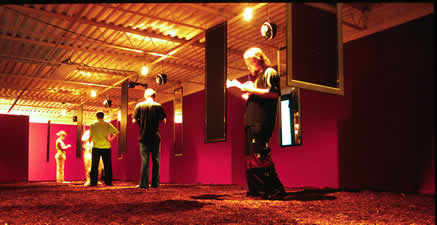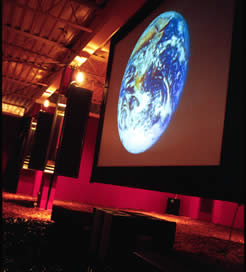The I and the Ear
The Art of installations
Installation art should consider and confront pivotally human questions on a personal level. It should allow the participants to slide out of the artist’s delivery of ideas and into an internal examination or genesis of their own ideas.

The physical journey through the installation allows the mind to process information differently than it would in a theatre and also allows for freedom of discovery and interaction in a way no performance can. The impact of ideas is more potent when one discovers them in an unconventional way. With my installation
The I Project, each person has the opportunity to control the delivery of the ideas presented by it, and so determine how he or she experiences them. Participants will also have the opportunity to contribute their own voice to the project, ultimately augmenting its content.
Participants
I think it is best to call the audience of my installation "participants" because "audience" tends to imply a sit-and-watch kind of passivity that I’m not aiming to inspire. Every participant will create a different presentation of sound through his or her own exploration, and the relationships within the environment of one participant to another will affect the aural shape of the room significantly. This makes the role of each participant intractable from the work itself. Without their investigation, the environment remains in an attentive resting state, waiting for someone to reveal the ideas buried there.

The visual aspect of any work is vital to the participant. I have found that the simplest visual component can create a strong connection between the audience and the sounds of a piece. The catch is that any image that occurs at the same time as a sound event–however incongruous the two may be–can’t help but be associated with each other by the person experiencing them. The act of associating sound and image is as old as the structure of our brains. My challenge, then, is to establish a situation in which the visual elements continuously direct focus on the aural core of the work.
The I Project
The I Project makes extensive use of mirrors–the perfect tool for self-analysis. Most people use a mirror to make sure that the visual impression they present to others matches the self-image they carry in their imagination. Confronting a mirror can therefore be somewhat unsettling, for we notice the reality of our form more clearly the longer we study our reflection. The video component of the work serves as a release from this intense self-study, and allows the participant to consider her or himself as part of a much larger picture. As each speaker in the aural universe of the artwork reveals his or her own ideas about identity and individuality, it is my hope that the visual components of The I Project will build an environment that puts these ideas into a personal context.
Every room has its own character, its own energy, and the challenge of reaching a balance between the attitude of the room and the artwork it houses can be rewarding in and of itself. The benefit of working in an art gallery setting, however, is that the audience approaches the space with the expectation of having an artistic experience–enjoyment, entertainment, enlightenment or at the very least, diversion. A factory floor, a church or an open field can certainly be worked to contribute positively to an artwork, but the sense of event is different there. I would like people to focus on themselves in relation to the ideas in The I Project. A setting with a strong character would offer too many distractions.
Audio Environments

My current fascination with audio environments lies partly in my ability as an artist to pattern environmental sound-creating a comprehensible, meaningful answer to aural situations in daily life. The monologues for "The I Project" exist within a definite structure, but the words are the same as those we hear in a busy restaurant or at the back of a bus. By encouraging participants to pick out voices in this manufactured crowd, I certainly hope to transmit my ideas on the nature of ‘I’, and to awaken the participant’s ears to the magic of overlapping sound in the less-constructed world of every day life.
There is such an abundance of indirect language in our society–in business, on television, radio and popular film–that we have fallen out of the practice of open, free, and direct language with others. Yet it is only through this kind of interchange that people may reach a true understanding of each other.
Understanding ‘self’ must be a constant journey of the mind–for the mind and the ‘self’ are in constant flux. It is my hope that The I Project will serve as a signpost on that journey, and that it will ultimately encourage participants to seek out an understanding of themselves and others.
Social top